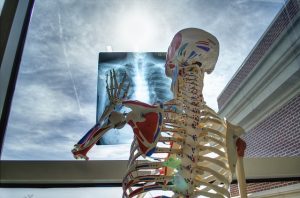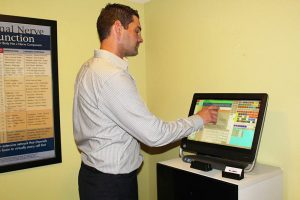Patients Who Receive Regular Chiropractic Care are Healthier
The experience of many patients who receive chiropractic adjustments is that with regular chiropractic treatment they feel healthier, don’t get ‘sick’ as often, and certain body ‘ills’ tend to improve without drugs or other medical intervention.
How does this occur if chiropractic simply moves bones and reduces joint inflammation?
The answer was discovered almost 100 years ago. Back in 1921, a medical doctor, Henry Winsor, set about to understand if, in fact, there was a correlation between certain areas of the spine having misalignments (the official term is subluxations) and malfunction of organs.
Dr Winsor hailed from Haverford, Pennsylvania and he posed the following question: “Chiropractors claim that by adjusting one vertebra [bone of the spine], they can relieve stomach troubles and ulcers; by adjusting another, menstrual cramps; and by adjusting other parts of the spine conditions such as kidney diseases, constipation, heart disease, thyroid conditions, and lung disease may resolve – but how?”
After graduating from medical school, Dr. Winsor was inspired by chiropractic and osteopathic literature to experiment with these concepts. He planned to dissect human and animal cadavers to see if there was a relationship between any diseased internal organs and the vertebrae (bones of the spine) associated with the nerves that traveled to those organs.
As he wrote: “The object of these necropsies [dissections] was to determine whether any connection existed between curvatures of the spine (vertebra misalignments), and diseased organs; or whether the two were entirely independent of each other.”

A Little About Your Nervous System – the link from organs to brain
To understand Dr Winsor’s work, we need to discuss and understand the nervous system. The human nervous system is divided into different parts:
• There is the central nervous system (CNS) composed of the brain and spinal cord – this is the master human computer and its primary connecting cord with the rest of the body.
• Then there is the peripheral nervous system (PNS) which includes all the nerves carrying messages to and from the central nervous system that connect to muscles (consciously controlled – you decide to wiggle your little finger and it moves) and organs (unconsciously controlled – you don’t need to tell your heart to beat for it to do so).
• That aspect of the PNS (peripheral nervous system) that regulates functions automatically (unconsciously) is called the autonomic nervous system (ANS).
• The autonomic nervous system is itself divided into the sympathetic nervous system (which tends to speed things up) and the parasympathetic nervous system (which tends to slow things down). The nerves of the ANS that go to organs and control their function pass each vertebral level along the spine. So too do the nerves that travel to muscles that are consciously controlled.
If one or more vertebrae are out of place (misaligned) causing inflammation, this inflammation can put pressure on a nerve traveling from the spinal cord and going to either muscles or organs, having a negative influence on their functioning.
100% Correlation Found Between Spinal Irritation & Disease
The University of Pennsylvania gave Dr. Winsor permission to carry out his experiments. In a series of three studies he dissected a total of seventy-five human and twenty-two cat cadavers. The following are Dr. Winsor’s results:
“221 structures other than the spine were found diseased. Of these, 212 were observed to belong to the same sympathetic (nerve) segments as the vertebrae in curvature. In other words, there was nearly a 100% correlation between minor curvatures of the spine and diseases of the internal organs.”
| Heart Disease All 20 cases with heart and pericardium conditions had the upper five thoracic vertebrae misaligned (T1-T5). |
Pancreas All 3 cases with pancreas disease had spinal misalignments in the mid-thoracic area (T5-T9). |
| Lung Disease All 26 cases of lung disease had spinal misalignments in the upper thoracic area (T1-T5). |
Spleen All 11 cases with spleen disease had spinal misalignments in the mid-thoracic area (T5-T9). |
| Stomach Disease All 9 cases of stomach disease had spinal misalignments in the mid-thoracic (T5-T9) area. |
Kidney All 17 cases with kidney disease were out of alignment in the lower thoracic area (T10-T12). |
| Liver Disease All 13 cases of liver disease had misalignments in the mid-thoracic area (T5-T9). |
Prostate and Bladder Disease All 8 cases with prostate disease had the lumbar vertebrae misaligned (L1-L5). |
| Gallbladder All 5 cases of gallstone disease had spinal misalignments in the mid-thoracic area (T5-T9). |
Uterus 2 cases with uterine conditions had the second lumbar (L2) misaligned. |
The “T” and “L” mentioned above refer to the thoracic (T) and lumbar (L) spine respectively. The thoracic spine is the mid-back region and the lumbar spine is the lower back. Most nerves traveling to major organs exit the spine from the mid back or thoracic region. The reproductive organs sit low in the body and they are therefore associated with the nerves from the lumbar spine.
Dr. Winsor’s results are published in The Medical Times and are found in any medical library. Winsor was not alone in his findings. Similar studies by other researchers have confirmed Dr. Winsor’s conclusion that degenerated and misaligned spines have a high correlation with disease processes.
So what are your thoughts? Does it seem important to keep the vertebra of your spine in the correct alignment?


 At Jones Family Chiropractic we offer in-house x-rays as a convenience to our patients so they don’t have to be referred out to another location.
At Jones Family Chiropractic we offer in-house x-rays as a convenience to our patients so they don’t have to be referred out to another location. Jones Family Chiropractic utilizes a state of the art software system that assists with all aspects of chiropractic care. Analysis, results, treatment schedules and progress are all kept in our system. Each time you visit us your private and secure patient history is available for you and Dr. Jones to review and discuss.
Jones Family Chiropractic utilizes a state of the art software system that assists with all aspects of chiropractic care. Analysis, results, treatment schedules and progress are all kept in our system. Each time you visit us your private and secure patient history is available for you and Dr. Jones to review and discuss. Complimentary 15 Minute Consultation*
Complimentary 15 Minute Consultation*